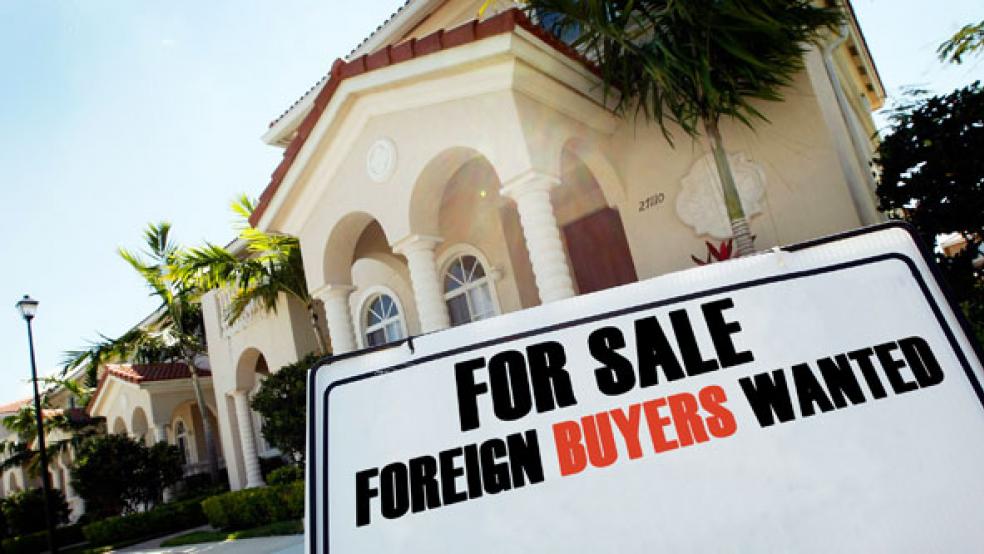South Florida is sizzling. And for the first time in years, we’re talking about real estate, not weather.
International home buyers are scooping up homes in cities like Kisimmee, Fort Lauderdale, Miami, Orlando, and Naples. Last year, Europeans, Canadians, and Brazilians spent approximately $13 billion on homes in Florida; 6 out of the top 10 cities searched on real estate search engine Trulia.com by international buyers last quarter were located in Florida.
Nationwide, international buyers were a rare bright spot in the U.S. housing market. Last year, they purchased $41 billion worth of residential property, according to the National Association of Realtors (NAR). And the share of international buyers paying cash for U.S. properties has risen steadily. NAR found 62 percent of total foreign purchases last year were all-cash, up from 55 percent in 2010.
Though foreign buyers accounted for only about 4 percent of existing home sales overall, experts say they may have helped prevent further price declines in some markets. Is that a signal that the housing market is finally beginning to bottom out? “The high percentage of all-cash [transactions] implies that this is smart money,” says Lawrence Yun, chief economist with the National Association of Realtors. Cash buyers “generally like to move one step ahead of the general population,” he says. “And given the high percentage of all cash, we may be at the early stages of home-value stabilization.”
A perfect storm of economic events have made the U.S. especially attractive to foreign home buyers. The dollar is relatively weak against many foreign currencies. In the last year the Euro appreciated 18 percent against the US dollar. Meanwhile, U.S. home prices have retreated to 2002 levels, and the market remains bogged down by an oversupply of inventory. “The increasingly favorable affordability and valuations environment, particularly for buyers from overseas, remains the one beacon of hope for the housing market,” according to Paul Dales, economist with Capital Economics.
While foreign buyers are investing in nearly every state, 58 percent of international property purchases are in Florida, California, Texas, and Arizona. Florida alone accounts for 31 percent of sales. The sunshine state has one big thing going for it: Rock-bottom prices. During the housing boom, Florida was among the hottest real-estate markets in the country. But it was hammered during the recession and now has a glut of distressed properties. Nearly 20 percent of Florida’s homes sat vacant in March, according to a report by the Census Bureau. Home sellers slashed about $24 billion in value from homes in the last 12 months, of which $3 billion alone was cut from Florida properties, according to Trulia.
That’s helping jump-start sales. “In the Miami-Dade market alone, realtors are on pace to sell more single-family homes and condos than they ever have in history,” says Ron Shuffield, President of Coral Gables-based Esslinger-Wooten-Maxwell Realtors (EWM). “The fact that we are offering tremendous values is the fuel that is driving sales. [Foreign buyers] are getting an extra coupon every time they buy from us because they are able to use their currency.”
In Miami-Dade an average of 2,461 single-family homes and condos sold each month from January through May of this year, a 131 percent increase over 2008 and a 35 percent increase over last year. At the end of May, the average price for a single-family home there was $180,000 down from $400,000 in 2007. Condos dropped to an average $124,000 from $275,000 during the same period.
Given that many nonresidents are limited to six-month stays in the U.S., many foreign buyers are looking for vacation homes. In addition to bargain prices, proximity to home, convenience of air transportation, and climate are important considerations for international purchasers. And Florida’s year-round sunshine and white, sandy beaches are top assets for realtors, along with the allure of southern Florida’s cultural diversity.
“We are on fire down here and it’s not just transactions,” says Jack Levine, chairman of the Miami Association of Realtors. “It’s the lifestyle, the weather, the multiculturalism. You see celebrities all the time.” Levine estimates that nearly 60 percent of all sales last year throughout the Miami-Dade area were to foreign buyers.
In addition to Latin American buyers, Florida’s cities are popular among buyers from Canada, Brazil, Argentina, and Sweden. Canadians account for nearly a quarter of all international purchases, according to Capital Economics. The fall in the U.S. dollar against the Canadian dollar means that the 33 percent drop in U.S. house prices since 2006 has translated into a 43 percent decline when priced in Canadian dollars. Relative to Canadian disposable income, U.S. housing looks undervalued by 30 percent. And given the long, cold Canadian winters, Florida is enormously appealing.
Not surprisingly, real estate outfits are focusing on potential clients in these countries. Paolo Bomfim, associate at EWM Realtors, has been targeting Brazilian investors over the last year and says nearly 100 percent of his sales have been international. All of his buyers are high end, paying cash for properties priced at $500,000 and more. Approximately 67 percent of sales at EWM Realtors are cash transactions in $1 million plus market, he says.
A few hours north in Orlando, real estate firms also are riding a wave of international buyers. “There is no question [international buyers] are enhancing the local housing market,” says Phil Coffaro, an agent with RE/Max in Orlando. Coffaro says there has been a significant decline in inventory over the past year. There were 22,000 homes for sale in the Orlando metropolitan area last year, and now it’s down to just fewer than 14,000.
As property inventories are depleted across Florida, home values are starting to rise again. From the beginning of the year through the end of May, single-family-home values in Miami-Dade have increased 20 percent, while condo values rose 38 percent. But as with every cycle, certain areas will improve earlier than others. Miami was one of the first markets to see home prices crash in 2006 and 2007, and now it is one of the first to experience an uptick. “We are once again having many multiple offers for listed properties,” says EMW’s Shuffield. “The only thing that is holding back a stable increase in values is the fear of the distressed properties that are still lurking in the background.”
Related Links:
Foreclosures: Luxury Homes on the Auction Block (The Fiscal Times)
Investors are Flipping Over Low Home Prices (The Fiscal Times)
Retirement Dreams Fade as Home Sales Slide Further (The Fiscal Times)



